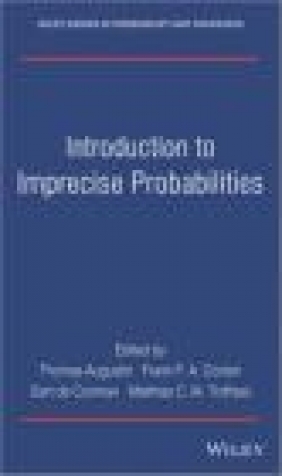Introduction to Imprecise Probabilities
Introduction to Imprecise Probabilities
- Producent: Blackwell Science
- Rok produkcji: 2014
- ISBN: 9780470973813
- Ilość stron: 448
- Oprawa: Twarda
Niedostępna
Opis: Introduction to Imprecise Probabilities
In recent years, the theory has become widely accepted and has been further developed, but a detailed introduction is needed in order to make the material available and accessible to a wide audience. This will be the first book providing such an introduction, covering core theory and recent developments which can be applied to many application areas. All authors of individual chapters are leading researchers on the specific topics, assuring high quality and up-to-date contents. An Introduction to Imprecise Probabilities provides a comprehensive introduction to imprecise probabilities, including theory and applications reflecting the current state if the art. Each chapter is written by experts on the respective topics, including: Sets of desirable gambles; Coherent lower (conditional) previsions; Special cases and links to literature; Decision making; Graphical models; Classification; Reliability and risk assessment; Statistical inference; Structural judgments; Aspects of implementation (including elicitation and computation); Models in finance; Game-theoretic probability; Stochastic processes (including Markov chains); Engineering applications. Essential reading for researchers in academia, research institutes and other organizations, as well as practitioners engaged in areas such as risk analysis and engineering.Preface Introduction Acknowledgements Outline of this Book and Guide to Readers Contributors 1 Desirability 1.1 Introduction 1.2 Reasoning about and with Sets of Desirable Gambles 1.2.1 Rationality Criteria 1.2.2 Assessments Avoiding Partial or Sure Loss 1.2.3 Coherent Sets of Desirable Gambles 1.2.4 Natural Extension 1.2.5 Desirability Relative to Subspaces with Arbitrary Vector Orderings 1.3 Deriving & Combining Sets of Desirable Gambles 1.3.1 Gamble Space Transformations 1.3.2 Derived Coherent Sets of Desirable Gambles 1.3.3 Conditional Sets of Desirable Gambles 1.3.4 Marginal Sets of Desirable Gambles 1.3.5 Combining Sets of Desirable Gambles 1.4 Partial Preference Orders 1.4.1 Strict Preference 1.4.2 Nonstrict Preference 1.4.3 Nonstrict Preferences Implied by Strict Ones 1.4.4 Strict Preferences Implied by Nonstrict Ones 1.5 Maximally Committal Sets of Strictly Desirable Gambles 1.6 Relationships with Other, Nonequivalent Models 1.6.1 Linear Previsions 1.6.2 Credal Sets 1.6.3 To Lower and Upper Previsions 1.6.4 Simplified Variants of Desirability 1.6.5 From Lower Previsions 1.6.6 Conditional Lower Previsions 1.7 Further Reading 2 Lower Previsions 2.1 Introduction 2.2 Coherent Lower Previsions 2.2.1 Avoiding Sure Loss and Coherence 2.2.2 Linear Previsions 2.2.3 Sets of Desirable Gambles 2.2.4 Natural Extension 2.3 Conditional Lower Previsions 2.3.1 Coherence of a Finite Number of Conditional Lower Previsions 2.3.2 Natural Extension of Conditional Lower Previsions 2.3.3 Coherence of an Unconditional and a Conditional Lower Prevision 2.3.4 Updating with the Regular Extension 2.4 Further Reading 2.4.1 The Work of Williams 2.4.2 The Work of Kuznetsov 2.4.3 The Work of Weichselberger 3 Structural Judgements 3.1 Introduction 3.2 Irrelevance and Independence 3.2.1 Epistemic Irrelevance 3.2.2 Epistemic Independence 3.2.3 Envelopes of Independent Precise Models 3.2.4 Strong Independence 3.2.5 The Formalist Approach to Independence 3.3 Invariance 3.3.1 Weak Invariance 3.3.2 Strong Invariance 3.4 Exchangeability. 3.4.1 Representation Theorem for Finite Sequences 3.4.2 Exchangeable Natural Extension 3.4.3 Exchangeable Sequences 3.5 Further Reading 3.5.1 Independence. 3.5.2 Invariance 3.5.3 Exchangeability 4 Special Cases 4.1 Introduction 4.2 Capacities and n-monotonicity 4.3 2-monotone Capacities 4.4 Probability Intervals on Singletons 4.5 1-monotone Capacities 4.5.1 Constructing 1-monotone Capacities 4.5.2 Simple Support Functions 4.5.3 Further Elements 4.6 Possibility Distributions, p-boxes, Clouds and Related Models. 4.6.1 Possibility Distributions 4.6.2 Fuzzy Intervals 4.6.3 Clouds 4.6.4 p-boxes. 4.7 Neighbourhood Models 4.7.1 Pari-mutuel 4.7.2 Odds-ratio 4.7.3 Linear-vacuous 4.7.4 Relations between Neighbourhood Models 4.8 Summary 5 Other Uncertainty Theories Based on Capacities 5.1 Imprecise Probability = Modal Logic + Probability 5.1.1 Boolean Possibility Theory and Modal Logic 5.1.2 A Unifying Framework for Capacity Based Uncertainty Theories 5.2 From Imprecise Probabilities to Belief Functions and Possibility Theory 5.2.1 Random Disjunctive Sets 5.2.2 Numerical Possibility Theory 5.2.3 Overall Picture 5.3 Discrepancies between Uncertainty Theories 5.3.1 Objectivist vs. Subjectivist Standpoints 5.3.2 Discrepancies in Conditioning 5.3.3 Discrepancies in Notions of Independence 5.3.4 Discrepancies in Fusion Operations 5.4 Further Reading 6 Game-Theoretic Probability 6.1 Introduction 6.2 A Law of Large Numbers 6.3 A General Forecasting Protocol 6.4 The Axiom of Continuity 6.5 Doob's Argument 6.6 Limit Theorems of Probability 6.7 Levy's Zero-One Law. 6.8 The Axiom of Continuity Revisited 6.9 Further Reading 7 Statistical Inference 7.1 Background and Introduction 7.1.1 What is Statistical Inference? 7.1.2 (Parametric) Statistical Models and i.i.d. Samples 7.1.3 Basic Tasks and Procedures of Statistical Inference 7.1.4 Some Methodological Distinctions 7.1.5 Examples: Multinomial and Normal Distribution 7.2 Imprecision in Statistics, some General Sources and Motives 7.2.1 Model and Data Imprecision; Sensitivity Analysis and Ontological Views on Imprecision 7.2.2 The Robustness Shock, Sensitivity Analysis 7.2.3 Imprecision as a Modelling Tool to Express the Quality of Partial Knowledge 7.2.4 The Law of Decreasing Credibility 7.2.5 Imprecise Sampling Models: Typical Models and Motives 7.3 Some Basic Concepts of Statistical Models Relying on Imprecise Probabilities 7.3.1 Most Common Classes of Models and Notation 7.3.2 Imprecise Parametric Statistical Models and Corresponding i.i.d. Samples. 7.4 Generalized Bayesian Inference 7.4.1 Some Selected Results from Traditional Bayesian Statistics. 7.4.2 Sets of Precise Prior Distributions, Robust Bayesian Inference and the Generalized Bayes Rule 7.4.3 A Closer Exemplary Look at a Popular Class of Models: The IDM and Other Models Based on Sets of Conjugate Priors in Exponential Families. 7.4.4 Some Further Comments and a Brief Look at Other Models for Generalized Bayesian Inference 7.5 Frequentist Statistics with Imprecise Probabilities 7.5.1 The Non-robustness of Classical Frequentist Methods. 7.5.2 (Frequentist) Hypothesis Testing under Imprecise Probability: Huber-Strassen Theory and Extensions 7.5.3 Towards a Frequentist Estimation Theory under Imprecise Probabilities- Some Basic Criteria and First Results 7.5.4 A Brief Outlook on Frequentist Methods 7.6 Nonparametric Predictive Inference (NPI) 7.6.1 Overview 7.6.2 Applications and Challenges 7.7 A Brief Sketch of Some Further Approaches and Aspects 7.8 Data Imprecision, Partial Identification 7.8.1 Data Imprecision 7.8.2 Cautious Data Completion 7.8.3 Partial Identification and Observationally Equivalent Models 7.8.4 A Brief Outlook on Some Further Aspects 7.9 Some General Further Reading 7.10 Some General Challenges 8 Decision Making 8.1 Non-Sequential Decision Problems 8.1.1 Choosing From a Set of Gambles 8.1.2 Choice Functions for Coherent Lower Previsions 8.2 Sequential Decision Problems 8.2.1 Static Sequential Solutions: Normal Form 8.2.2 Dynamic Sequential Solutions: Extensive Form 8.3 Examples and Applications 8.3.1 Ellsberg's Paradox 8.3.2 Robust Bayesian Statistics 9 Probabilistic Graphical Models 9.1 Introduction 9.2 Credal Sets 9.2.1 Definition and Relation with Lower Previsions 9.2.2 Marginalisation and Conditioning 9.2.3 Composition. 9.3 Independence 9.4 Credal Networks 9.4.1 Non-Separately Specified Credal Networks 9.5 Computing with Credal Networks 9.5.1 Credal Networks Updating 9.5.2 Modelling and Updating with Missing Data 9.5.3 Algorithms for Credal Networks Updating 9.5.4 Inference on Credal Networks as a Multilinear Programming Task 9.6 Further Reading 10 Classification 10.1 Introduction 10.2 Naive Bayes 10.3 Naive Credal Classifier (NCC) 10.4 Extensions and Developments of the Naive Credal Classifier 10.4.1 Lazy Naive Credal Classifier 10.4.2 Credal Model Averaging 10.4.3 Profile-likelihood Classifiers 10.4.4 Tree-Augmented Networks (TAN) 10.5 Tree-based Credal Classifiers 10.5.1 Uncertainty Measures on Credal Sets. The Maximum Entropy Function. 10.5.2 Obtaining Conditional Probability Intervals with the Imprecise Dirichlet Model 10.5.3 Classification Procedure 10.6 Metrics, Experiments and Software 10.6.1 Software. 10.6.2 Experiments. 11 Stochastic Processes 11.1 The Classical Characterization of Stochastic Processes 11.1.1 Basic Definitions 11.1.2 Precise Markov Chains 11.2 Event-driven Random Processes 11.3 Imprecise Markov Chains 11.3.1 From Precise to Imprecise Markov Chains 11.3.2 Imprecise Markov Models under Epistemic Irrelevance. 11.3.3 Imprecise Markov Models Under Strong Independence. 11.3.4 When Does the Interpretation of Independence (not) Matter? 11.4 Limit Behaviour of Imprecise Markov Chains 11.4.1 Metric Properties of Imprecise Probability Models 11.4.2 The Perron-Frobenius Theorem 11.4.3 Invariant Distributions 11.4.4 Coefficients of Ergodicity 11.4.5 Coefficients of Ergodicity for Imprecise Markov Chains. 11.5 Further Reading 12 Financial Risk Measurement 12.1 Introduction 12.2 Imprecise Previsions and Betting 12.3 Imprecise Previsions and Risk Measurement 12.3.1 Risk Measures as Imprecise Previsions 12.3.2 Coherent Risk Measures 12.3.3 Convex Risk Measures (and Previsions) 12.4 Further Reading 13 Engineering 13.1 Introduction 13.2 Probabilistic Dimensioning in a Simple Example 13.3 Random Set Modelling of the Output Variability 13.4 Sensitivity Analysis 13.5 Hybrid Models. 13.6 Reliability Analysis and Decision Making in Engineering 13.7 Further Reading 14 Reliability and Risk 14.1 Introduction 14.2 Stress-strength Reliability 14.3 Statistical Inference in Reliability and Risk 14.4 NPI in Reliablity and Risk 14.5 Discussion and Research Challenges 15 Elicitation 15.1 Methods and Issues 15.2 Evaluating Imprecise Probability Judgements 15.3 Factors Affecting Elicitation 15.4 Further Reading 16 Computation 16.1 Introduction 16.2 Natural Extension 16.2.1 Conditional Lower Previsions with Arbitrary Domains. 16.2.2 The Walley-Pelessoni-Vicig Algorithm 16.2.3 Choquet Integration 16.2.4 Mobius Inverse 16.2.5 Linear-Vacuous Mixture 16.3 Decision Making 16.3.1 Maximin, Maximax, and Hurwicz 16.3.2 Maximality 16.3.3 E-Admissibility 16.3.4 Interval Dominance References Author index Subject index
Szczegóły: Introduction to Imprecise Probabilities
Tytuł: Introduction to Imprecise Probabilities
Producent: Blackwell Science
ISBN: 9780470973813
Rok produkcji: 2014
Ilość stron: 448
Oprawa: Twarda
Waga: 0.84 kg






























